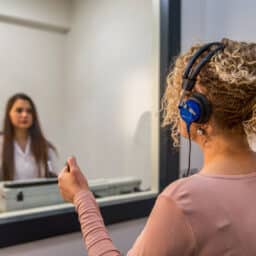Here’s How You Can Play Sports With Hearing Aids

Staying active is a crucial part of staying healthy. Current recommendations are that adults over the age of 18 should get 150 minutes of moderate physical activity a week or 75 minutes of vigorous physical activity. Some people like taking yoga classes or regular walks through Golden Gate Park Loop or other San Francisco trails….
What New Technology Do the Latest Hearing Aids Offer?

Hearing aid technology continues to improve and evolve, offering users better listening experiences in different environments. Let’s take a look at some of the new technology that today’s hearing aids have to offer! Directional Microphones Traditional microphones pick up sound from all directions equally. Since people with hearing loss can struggle to pinpoint where sound…
How Hearing Aids Increase Brain Activity

One of the more serious side effects of untreated hearing loss is that it can impact brain function and put you at a greater risk for cognitive decline and dementia. Thankfully, using hearing aids can help reduce your risk and actually increase brain activity. Hearing Loss Is Bad for The Brain If you have hearing…
Benefits of a Hearing Test

According to a study published in the journal Hearing Technology Assessment, “A simple systematic screen, using an audiometric screening instrument, is acceptable to people in the age range 55-74 years, is likely to provide substantial benefit and may be cost-effective to those in that target group.” Besides being cost-effective, there are many benefits to getting…
How to Get the Most Out of Your Hearing Aids This Year

The National Institute on Deafness and Other Communication Disorders reports that, “Among adults aged 70 and older with hearing loss who could benefit from hearing aids, fewer than one in three (30 percent) has ever used them. Even fewer adults aged 20 to 69 (approximately 16 percent) who could benefit from wearing hearing aids have…
Reasons To Make a Hearing Test Your New Year’s Resolution

It’s hard to believe that another year is coming to a close. As you prepare to look ahead to 2023, you’re probably thinking about the goals you want to achieve and experiences you hope to enjoy. If you have hearing loss, having a hearing test and seeking treatment can help ensure you make the most…
Waterproof & Water-Resistant Hearing Aids: What’s the Difference?

An article published in the journal Trends in Amplification listed “performance in quiet settings, comfort, feedback, frequency of battery replacement, purchase price, water and sweat resistance, and performance in noisy settings” as the top requested hearing aid features among consumers. In this post, we focus on the feature “water and sweat resistance” – more specifically,…
Communication Strategies for People With Hearing Aids

Hearing aids are an absolute life-changer for anyone with hearing loss. They make everything from going to the symphony to catching up with your grandchildren at The Ice Cream Bar easier and more enjoyable. However, it’s important to remember that hearing aids aren’t magical devices that can offer you perfect hearing in every environment. After…
Over-the-Counter Hearing Aids Increase Accessibility to Treatment
If you’ve heard of over-the-counter hearing aids, then you may have also heard you don’t need a prescription to purchase them. While they are convenient to buy and often cheaper than the prescription hearing aid alternative, patients will benefit from a licensed medical professional’s oversight. They can function as a self-serve option, but did you…
Navigating Different Listening Environments with Hearing Aids

Throughout our day, we can find ourselves in many different listening environments. Whether you’re enjoying a quiet morning at home, working in a bustling office, or listening to live music during a night out at Sheba Piano Lounge, you want to make sure your hearing aids provide the best listening experience in any environment. How…
